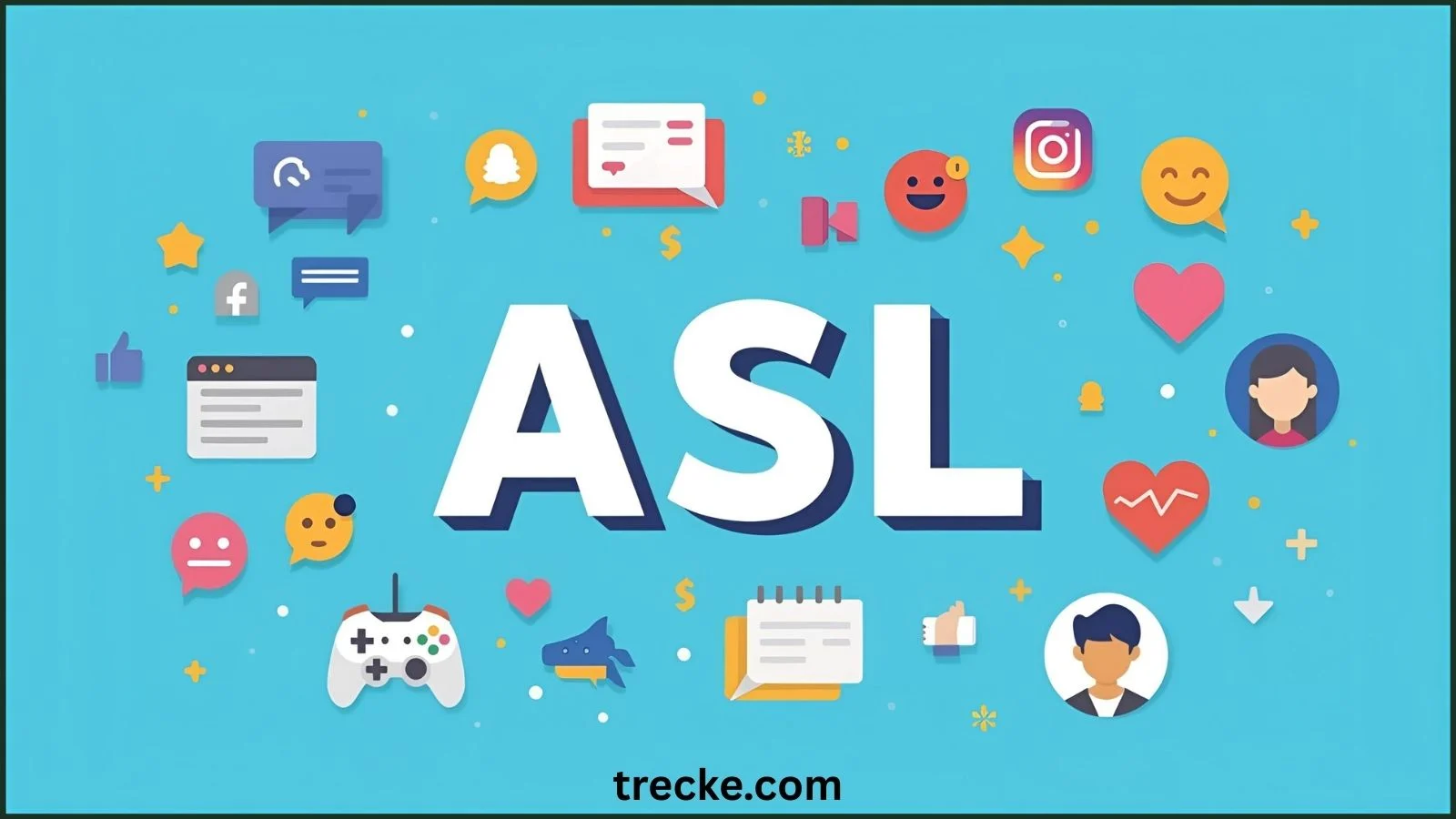Have you ever seen “ASL” in a text, chat, or social media post and wondered, what does ASL actually mean? 🤔
Quick Reply: ASL usually stands for “Age, Sex, Location,” a shorthand used to start conversations and quickly get to know someone online.
This acronym is common in chatrooms, messaging apps, gaming communities, and dating platforms.
Understanding ASL is important not just for clarity, but also to protect your privacy. While it’s casual, misusing it or oversharing details can create uncomfortable situations.
Think of it this way: when someone asks for your ASL, they’re asking for the basics—but it’s also an opportunity to respond safely and creatively, depending on your comfort level.
Definition & Meaning
ASL is an acronym that stands for Age, Sex, Location. It’s used in online conversations to quickly gather basic information about someone.
Example in a chat:
- User1: “ASL?”
- User2: “22/F/NYC”
Example in online communities:
- Forum post: “Looking to connect with people. ASL?”
Key Point: ASL is informal and primarily used in online interactions, especially when meeting new people. It’s not meant for professional or formal contexts.
Background & History
Origin
ASL first appeared in early internet chatrooms in the 1990s, when typing speed and brevity were important. Quick shorthand helped users communicate faster in text-based platforms.
Evolution
It became widely recognized through services like AOL chatrooms, MSN Messenger, and ICQ. Over time, ASL spread to modern platforms like Discord, WhatsApp, and dating apps.
Modern Usage
While it’s less common today due to privacy concerns, ASL still appears in casual chats, Discord servers, and dating apps. Understanding its history helps explain why it’s considered informal, fast, and conversational.
Pro Tip: Knowing ASL’s origins helps you use it appropriately, and also recognize when someone’s asking in a casual, friendly way versus a risky context.
Usage in Various Contexts
1. Online Chatrooms / Messaging
ASL is often used to quickly get to know someone new.
Example:
- User1: “Hey! ASL?”
- User2: “19/M/California”
Tip: Combine ASL with friendly conversation instead of using it as the only interaction.
2. Gaming Communities
Gamers might ask ASL to find teammates with similar age or region.
Example:
- Player1: “ASL?”
- Player2: “23/F/NYC, ready for the match!”
Pro Tip: Only share general information, not exact addresses or personal details.
3. Dating Apps
ASL is common when starting a conversation to gauge basic compatibility.
Example:
- Profile message: “Hi! ASL?”
- Reply: “25/M/Chicago”
Safety Tip: Avoid giving precise locations or overly personal information in public chats.
Common Misconceptions & Clarifications
Misconception 1: ASL is universally safe.
Clarification: Sharing personal info can be risky; never give exact location publicly.
Misconception 2: ASL is only used by teens.
Clarification: Anyone on chat platforms or dating apps may encounter it.
Misconception 3: ASL is outdated.
Clarification: It’s less common now but still recognized in specific online communities.
Similar Terms & Alternatives
| Term | Meaning | Example |
|---|---|---|
| Age/Gender/Location | Full form of ASL | “Age/Gender/Location?” |
| DM / PM | Private messaging | Used instead of sharing info publicly |
| Bio Info | Profile information | “Check my bio for details” |
| Intro Questions | Casual getting-to-know-you | “Hi, what’s up? ASL?” |
How to Respond to ASL
Casual / Friendly:
- User: “ASL?”
- You: “22/F/NYC”
Privacy-Conscious:
- User: “ASL?”
- You: “I prefer not to share exact details, but I’m 20s/F”
Playful / Humorous:
- User: “ASL?”
- You: “Top secret 😎”
Professional / Neutral:
- ASL is not appropriate in professional contexts; instead, share name, position, and company.
Regional or Cultural Differences
- English-Speaking Countries: Common in chatrooms, Discord, and dating apps.
- Global Online Communities: Recognized widely, but usage frequency varies.
Tip: Always consider your audience and privacy before responding.
Comparison with Similar Terms
| Term | Meaning | Context | Notes |
|---|---|---|---|
| ASL | Age, Sex, Location | Online chat | Casual, fast question |
| DM / PM | Private message | Online chat | Safer alternative |
| Bio Info | Profile details | Social media | Public, optional |
| Intro Questions | Casual inquiry | Chat / messaging | Less direct than ASL |
Usage in Online Communities & Dating Apps
- Discord / Chatrooms: ASL appears when meeting new members.
- Dating Apps / Social Media: Quickly establishes basic details before chatting.
- Gaming Communities: Helps find teammates of similar age or region.
Pro Tip: Combine ASL with friendly conversation rather than relying solely on it.
Hidden or Offensive Meanings
- ASL is neutral itself, but misuse can lead to oversharing personal info.
- Always be mindful of context to avoid uncomfortable situations online.
Suitability for Professional Communication
- ASL is not appropriate in professional settings.
- Use name, title, company, or general location if relevant instead.
Also Visit: What Does Green Snot Mean in Text? | Slang Meaning, Use & Examples
Frequently Asked Questions (FAQ)
- What does ASL mean?
- It stands for Age, Sex, Location, used in online chats to ask basic info.
- Is ASL safe to share?
- Share cautiously; avoid giving exact location in public forums.
- Where is ASL commonly used?
- Chatrooms, Discord, dating apps, and online messaging.
- Can ASL be used professionally?
- No, use name and position instead.
- Is ASL outdated?
- Less common today, but still recognized in certain communities.
- Are there alternatives to ASL?
- Yes: Bio info, DM/PM, intro questions.
- How can I respond safely to ASL?
- Share general information, use playful answers, or politely decline if uncomfortable.
- Can ASL be used humorously?
- Yes! You can reply creatively, like “Top secret 😎” or “Mystery mode activated.”
Conclusion
ASL is a shorthand used in online chats to ask about age, sex, and location. Understanding it helps you navigate online conversations confidently, respond appropriately, and maintain privacy.
While its use has declined due to privacy concerns, it remains recognized in chatrooms, dating apps, and gaming communities. Next time someone asks for your ASL, you’ll know it’s a quick, casual way to start a conversation—and you’ll also know how to respond safely, cleverly, or playfully! 😎
Engagement Idea: Poll readers: “Have you ever been asked ASL online? – Yes / No / Sometimes”
Visual Suggestion: Illustration featuring “ASL” in bold letters surrounded by chat bubbles, gaming controllers, social media icons, and playful emojis, using a bright, flat, colorful style for a modern blog feature image.











